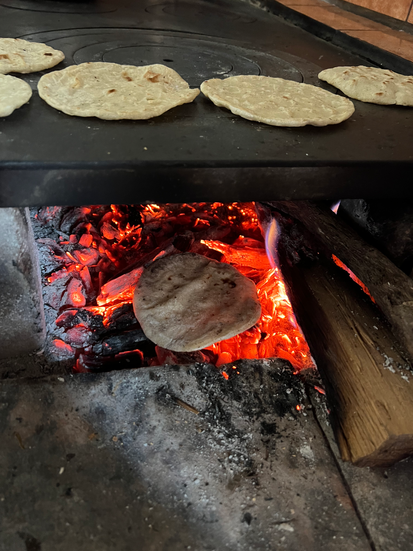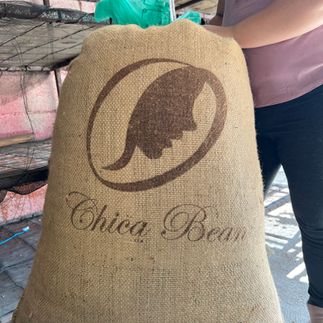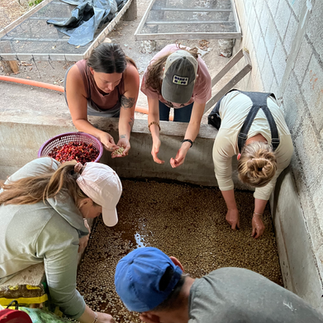It’s March, which means the end of the coffee harvest in Guatemala. It's also International Women’s month. And what could be more fitting to celebrate, than this woman coffee business owner making a trip to visit some incredible women coffee farmers and roasters wowing the international scene with their product, and their power.
So I jumped in the car with Abi, the Director of Sales for Chica Bean, and we made our way from the capital Guatemala City over to the Nuevo Oriente region of Guatemala into Mataquescuintla, nestled in the Jalapa mountains.

The town is a friendly, close-knit community. In place of an hola you might expect from neighbors passing by, its a va pue - some version of “how’s it going” - but warm nonetheless. Somehow, though, it feels like a ghost town. So many young folks, and middle-aged men, gone to the North to look for better opportunities. They send back money to help with expenses, and build their houses for the future, but there’s a sense that many will never return. So many big, beautiful houses line the road, half-way built and empty, waiting for the future to arrive in Mataquescuintla.
One interesting thing about the men being gone, though, is that the women are the expert farmers in their place. I was lucky enough to be invited to coffee harvesting, and spending time alongside some powerhouse women and their families, for a few days.
Tio Coco and Tia Ana own the land where we’re staying at. With 9 children total - 7 in the US and 2 around Guatemala - it’s their daughter in law Susi who represents the real local powerhouse behind the farm, and is one of the women that represents Chica Bean locally. With so many of their kids in the North sending money back home, Tio Coco and Tia Ana have been able to purchase their land outright and install running water, electricity, and other modern niceties you don’t normally see on every smallholder farm.

Coco, Ana and Susi first got involved in Chica Bean through a connection with Eileen, a peace corps volunteer who lived and worked alongside the women of Mataquescuintla for a few years - witnessing the hardships and inequities of the coffee supply chain.
Smallholder coffee farmers (which make up a whopping 98% of coffee farmers in Guatemala) often don’t make enough money to invest in the infrastructure that would help them take advantage of all the value-add processing - things like washing bins, de-pulpers, drying beds, etc.
Most smallholder farmers do all the hard work to grow the little seed into a seedling into a full producing tree (3-5 years) and then endure the grueling harvest by hand of thousands of pounds of coffee cherries, only to sell to the first coyote (local middlemen traders) that pass by with a “take it or leave it” price. Coyotes are the first of many steps in an infamously long coffee supply chain.
Chica Bean started working with different smallholder women farmers in the region, helping families purchase de-pulpers, small fermenting tanks, as well as African beds for drying coffee. All these investments allow the families to sell processed coffee ready for roasting and export, rather than the coffee cherry off the tree, which can almost double the value of their product.
The other thing about most smallholder farmers - and the impending limitations of the supply chain - means most coffee growers in Guatemala don’t even get to taste their own coffee.
Not the case with Chica Bean. Abi – part of the Chica Bean roasting and sales team, helps shorten the supply chain and brings the end product back to the farmers, so they can enjoy not only the deliciousness of their product, but also the empowering understanding of the market and where their product sits in it.
On our visit this week, Abi has some roasted and ground coffee that Susi and Ilcia produced themselves last year. While we press the coffee through an aeropress in the field, under the light shade of a tall borbón coffee tree, I’m excited by the thought of these women sipping their own craft.
It’s not the first time they’ve tasted their own coffee - they typically roast on their comal over the fire and grind with the metate stone like everything else - but it’s still unique. I ask Susi, “Do you like the aeropress, or do you have another method you prefer to brew your coffee with?
Susi’s confused.
She says, “We put the coffee in a pot, heat it up, stir it up, and drink it all day.” This is where cafe de olla (coffee from the pot) comes from, if you’ve ever wondered.
And it’s a good thing Susi has so much caffeine at her fingertips! Beyond being a leader woman coffee farmer in the region, Susi takes care of the empty houses left by her sisters in California, is a mother to two young girls, is a caretaker for her Tia Ana recovering from surgeries, and that’s just the non-paid labor.
For most coffee farmers, the harvest doesn’t earn enough. So Susi makes and sells snacks at the elementary school and the Parque Central. She drives a snow cone cart around town for extra income. Oh, and don’t forget the tienda (convenience store) she runs close to the main road.
Still, among all the tenacity and work ethic of Susi, what's most impressive is her sense of humor. She remains curious about most things, and ready with a quick wit to lighten the mood.
The work of coffee harvesting is grueling. We’re nearly 7,000 feet above sea level, in a heavy equatorial heat, navigating very steep slopes where the coffee trees are planted. The soil is rich, but loose - good for the coffee, but challenging for the harvesters standing on it.
I’m watching my footing, wiping the sweat, trying not to fall in a hole, preparing just the right position to begin picking the dime size cherries off the tree. But only pick the ripest! You can’t swipe through with a tool and just pull them all off (although that’s what some machines do for the low grade coffee you find in the grocery store). For specialty coffee, you have to pick by hand, only the plump, juicy ones that more easily slide off the limb. It takes skill, time and patience – and speed.
I watch everyone else. I realize, eventually, you find a rhythm.
Tio Coco has a basket full in no time. By the end of the day, we together have collected about 150 pounds of cherries. Tio Coco will now put these in a sack and effortlessly roll it down the mountain to the processing facility.
I’m exhausted, to say the least. A hammock sounds nice. And a nice wash with the water from the pila. But not yet! We must process the coffee as soon as we get back to the house. Next we must place the ripe cherries through the depulper (a pedal operated fruit pulper), which means we take turns pedaling to squeeze the fruit pulp off the seed and out comes the coffee bean sliding into the tank filled with water to start fermenting. The highest quality is ensured, by picking by hand all those bits of cáscara that stayed on the coffee beans. It’s quality control by hand. The water from the pila is cold and almost jelly-like, the benefits of the mucilage layer of the coffee bean, which will soon disappear after the fermentation process.
Before bed Susi makes us dinner paired up with hand made corn tortillas and one more cup of coffee, as is tradition so you can sleep well, and we’re off to rest.
If you'd like to try coffee from Susi and the rest of these coffee growers at Chica Bean, come over to the Café and ask for Jalapa Natural Processed coffee. It’s got notes of dark red fruits, dark chocolate, cherry, and love.































The story of Artesanos Chica Bean is a wonderful celebration of craftsmanship and the art of making something meaningful. For those looking to connect with their creative process and craft their own unique path, archetypes oracle cards can offer valuable insights. These cards help you tap into your inner creativity, guiding you through the process of crafting your own story and artistic journey. Thank you for sharing this beautiful celebration of artistry and tradition!
For anyone starting their trading journey, selecting the right platform is crucial to ensure a smooth and successful experience. Winprofx stands out among the best trading platforms for beginners, offering an intuitive and user-friendly interface that simplifies the complexities of trading. With a range of educational resources, tools, and real-time market data, it provides newcomers with the knowledge and insights needed to make informed decisions. Winprofx supports various trading instruments, including forex, stocks, and commodities, allowing beginners to diversify their portfolios and explore different market sectors. The platform’s easy-to-navigate layout and comprehensive guides make it accessible for those with little to no trading experience, while its powerful features offer room for growth as users gain more expertise.
In addition to…
https://www.gevezeyeri.com/cinsel-sohbet/
https://www.gevezeyeri.com/yetiskin-sohbet/
https://ruscasinos3.info/gabile-sohbet-ve-cinsel-sohbet-uygulamasi/
https://casinovulcanplatinum.info/gabile-sohbet-ve-cinsel-sohbet-uygulamasi/
https://casino-promocode.info/gabile-sohbet-ve-cinsel-sohbet-uygulamasi/
https://casinoonlinewildjackpots.info/gabile-sohbet-ve-cinsel-sohbet-uygulamasi/
https://pokerproffi7.info/gabile-sohbet-ve-cinsel-sohbet-uygulamasi/
https://citykino.info/gabile-sohbet-ve-cinsel-sohbet-uygulamasi/
https://hausratversicherungde.info/gabile-sohbet-ve-cinsel-sohbet-uygulamasi/
https://casinoh.info/gabile-sohbet-ve-cinsel-sohbet-uygulamasi/
https://honiejoiiz.info/gabile-sohbet-ve-cinsel-sohbet-uygulamasi/
https://legalrex.com/gabile-sohbet-ve-cinsel-sohbet-uygulamasi/
http://yetiskinchat.yousher.com/edebi-bitiren-gabile-sohbet-ve-edebi-bitiren-gabile-chat
http://yetiskinsohbet.iamarrows.com/edebi-bitiren-gabile-sohbet-ve-edebi-bitiren-gabile-chat
http://yetiskinsohbet.lucialpiazzale.com/edebi-bitiren-gabile-sohbet-ve-edebi-bitiren-gabile-chat
http://yetiskinchat.lowescouponn.com/edebi-bitiren-cinsel-sohbet-ve-edebi-bitiren-cinsel-chat
http://yetiskinchat.trexgame.net/edebi-bitiren-cinsel-sohbet-ve-edebi-bitiren-cinsel-chat
http://yetiskinchat.theburnward.com/edebi-bitiren-cinsel-sohbet-ve-edebi-bitiren-cinsel-chat
http://opensource.platon.sk/forum/projects/viewtopic.php?t=10945435
http://opensource.platon.sk/forum/projects/viewtopic.php?t=10945437
https://teletype.in/@sohbetedin/sohbet
https://joy.link/sohbetedin
https://linkpop.com/canlisohbet
https://www.iglinks.io/sohbet-qgd?preview=true
https://flow.page/sohbetodalari
https://www.gevezeyeri.com/cinsel-sohbet/
https://www.gevezeyeri.com/yetiskin-sohbet/
https://casinoinform.info/edebi-bitiren-cinsel-sohbet-odalari-ve-edebi-bitiren-cinsel-chat-odalari/
https://casinolucky777.info/edebi-bitiren-cinsel-sohbet-odalari-ve-edebi-bitiren-cinsel-chat-odalari/
https://casinowins4.info/edebi-bitiren-cinsel-sohbet-odalari-ve-edebi-bitiren-cinsel-chat-odalari/
https://casinotopsonline.info/edebi-bitiren-cinsel-sohbet-odalari-ve-edebi-bitiren-cinsel-chat-odalari/
https://casinor.info/edebi-bitiren-cinsel-sohbet-odalari-ve-edebi-bitiren-cinsel-chat-odalari/
https://casinosourcecodes.info/edebi-bitiren-cinsel-sohbet-odalari-ve-edebi-bitiren-cinsel-chat-odalari/
https://casinospotz.info/edebi-bitiren-cinsel-sohbet-odalari-ve-edebi-bitiren-cinsel-chat-odalari/
https://casino-online-bet.info/edebi-bitiren-cinsel-sohbet-odalari-ve-edebi-bitiren-cinsel-chat-odalari/
https://casino-tricks.info/edebi-bitiren-cinsel-sohbet-odalari-ve-edebi-bitiren-cinsel-chat-odalari/
https://jpcasino196.info/edebi-bitiren-cinsel-sohbet-odalari-ve-edebi-bitiren-cinsel-chat-odalari/
https://seocasino888.info/edebi-bitiren-cinsel-sohbet-odalari-ve-edebi-bitiren-cinsel-chat-odalari/
https://mylinks.ai/sohbetoadalari
https://zez.am/Sohbetodalari
https://taplink.cc/sohbetodalari
https://linkpop.com/canlisohbet
https://onne.link/sohbetodalari
https://pokervkazino.info/ucretsiz-rastgele-goruntulu-sohbet-kamerali-sohbet-gabile-sohbet-canli-sohbet-cinsel-sohbet/